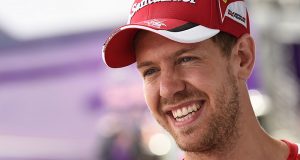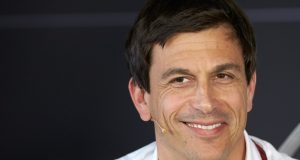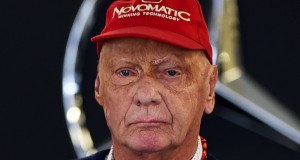The Renault F1 Team looks ahead to this weekend’s Spanish Grand Prix.
Robert Kubica: “I take a lot of positives from our start to the season”
Robert, after four races what is your assessment of your start to the season?
I think we should take a lot of positives from the first four races. If you had said to me at the start of the season, or even after Bahrain, that I would have scored 40 points and three top five finishes, I would have been more than happy. However, at the same time there has still been some frustration, especially in Shanghai where the safety car in the middle of the race definitely cost me a podium. But you have to accept that this is part of racing. Sometimes the luck goes your way and sometimes against you.
The team’s development rate is getting you right on the tail of Mercedes. It must be motivating to see the progress being made…
The whole team is working hard and it’s good that we’re making the most of our opportunities in the races. But it’s important to remain realistic because we still need some big steps to be at the front of the grid and fighting consistently with Red Bull and McLaren in normal conditions. The next race in Barcelona will be another big test for us because the return to Europe is usually a turning point in the season with many teams planning big upgrades to their cars.
Do you think the order of the teams will change again in Barcelona and that other teams may leapfrog ahead of you?
It’s something we always expect in Barcelona and a lot of the teams have big expectations for their new packages. We are not planning to bring any huge updates, but we will keep gradually improving the car, just like we did during the first four races. We have to wait and see how we compare with the others; maybe the order of the teams will be quite different compared to the start of the year.
What are your expectations for the weekend?
It’s the sort of circuit that all the drivers and teams know back to front so I’m expecting a very tough battle. All the teams will be very well prepared and usually get close to their potential so it’s important that we maximise our performance so that we can fight for points in the race.
Vitaly Petrov: “There is a great atmosphere in this team”
Vitaly, after four races, how do you assess the start of your F1 career?
The start of the year was quite difficult for me and there were a few missed opportunities in the first three races. For various reasons things did not work out for me: I made a mistake in Australia and there were some problems with the car in Bahrain and Malaysia. To finish the race in China and score my first points was a great feeling and helped make up for the disappointment of the earlier races. But I always want more, and now that I have finished seventh, I must aim even higher.
How valuable was it to complete a full race distance?
I learnt an enormous amount in Shanghai, especially because it was a wet race with changing track conditions. At the start of the race it was really difficult to know what the weather would do and if we needed to change tyres so I was talking with the team on the radio and making decisions about our strategy. Also, I learned about the importance of looking after the tyres and by the end of the race I was very quick and able to fight with Schumacher and Webber, who were both struggling with their tyres. The final laps were a lot of fun and I didn’t want the race to end!
You said recently that Renault feels like a family. Can you tell us about your relationship with the team?
That’s right, the team is just like a big family and I’m really happy to be part of it. We work well together and they are always trying to help me improve. I’ve said before that the determination of the team is what impresses me the most and the fact that there are so many people working hard to improve the car for each race. There is a great atmosphere in the garage and you can feel that everybody is giving their maximum.
We’re back in Europe now preparing for Barcelona, a circuit where you have a lot of experience. Are you looking forward to the race?
I’ve raced there many times in GP2 and we tested in Barcelona over the winter. It’s a circuit where all the teams will be well prepared and I expect the gaps between the cars to be very small. We didn’t have a very good test there in February, but hopefully the weather and track conditions will be different for the race and that will give us a chance to do better. As a circuit, it’s technically very difficult and overtaking is almost impossible, which is why qualifying will be very important.
Alan Permane: “We’ve maximised our opportunities so far”
Alan, after four flyaway races the team has scored 46 points. Did you expect such a positive start to the season?
I think it’s been a very encouraging start to the year and we’ve definitely maximised all the opportunities that have come our way, which is very important. We know that our outright pace is still behind the four fastest teams, but with our strategy from the pit wall and the performances of Robert and Vitaly, we have come away with more points than we might have expected.
Vitaly impressed in China with the maturity of his drive. How rewarding has it been to see his progress so far this year?
He deserves a lot of credit for the way he has tackled the start of the season. We’ve made no secret of the fact that he hasn’t had the easiest introduction to Formula 1, especially with the lack of dry running over the winter. He’s also missed out on race mileage with the car letting him down a couple of times already this season. To deliver such a strong performance in China was all the more impressive and shows how quickly he is learning about Formula 1.
Finishing his first race and getting points under his belt will surely have given him a big confidence boost…
He was very happy after the race and it’s a nice first reward for all his hard work. It will certainly give him a confidence boost, but more importantly he now has the experience of how the car behaves over a race distance. In particular, we saw how he managed to look after his intermediate tyres in Shanghai, passing more experienced drivers like Schumacher and Webber, which shows that he’s already racing intelligently and thinking his way through the races.
Robert continued his strong form in China with another outstanding drive. How much are you enjoying working with him?
His performances so far this year have been faultless and he’s squeezing every ounce of performance from the car on every lap. Just as impressive is his work ethic and dedication outside the cockpit, which is the most I have seen from any driver. He spends an enormous amount of time with his engineers at the track going over data, doing video analysis, and just trying to improve the car in any way he can. Seeing such commitment is a big motivation for the entire team.
Looking ahead to Barcelona, are you confident the problems the team experienced during the winter test have been put to bed?
It’s true that we didn’t look great during the Barcelona test and completed limited mileage, but the issues we had during the test were not circuit-specific and I’ve no concerns about going back there. Barcelona is one of those circuits where you pay a heavy penalty if you’re lacking aero efficiency, but we’ve added an enormous amount of downforce to the car since winter testing, so we shouldn’t be out of position. We won’t run the same set-up we used during the test because the car has evolved since then and the races have taught us a lot about how to get the most from it.
Is Barcelona still the ultimate test of a car’s aero package?
It’s certainly used to be the ultimate test, but since they slowed down the final sector, it’s not quite as aero-dependent as it used to be. However, the first part of the lap remains very high-speed, and turns three and nine are quick, challenging corners where good aero performance counts. Even turns four, five and seven are relatively quick corners by the standards of most circuits and, if your car has aero deficiencies, there’s nowhere to hide.
Most of the teams are expected to introduce big updates in Barcelona – are you anticipating a big shift in the pecking order?
I don’t think it will shift massively. Mercedes may move away from us a little bit but we’ve got a new front wing and some other new aerodynamic parts that should help us make another step forward. It’s not the biggest update we’ve had this year, but it continues our approach of adding new parts at each race. It will be very interesting to see how the situation shakes out between the different teams.
A lap of Barcelona with Robert Kubica
Barcelona is one of the best-known tracks for all the teams and drivers because of the testing miles we do there over the winter. The racing is never brilliant because it’s so hard to overtake, but it’s still a fun Grand Prix with a good atmosphere and enthusiastic Spanish fans.
The track layout is quite interesting with a few high-speed sections, as well as a very slow final sector. This means that you have to find a set-up compromise to cope with the range of corners. In the past, I preferred to go for a balance that suited the low-speed corners and I would live with the car in the high-speed sections. I always felt it was better to have low-speed traction and a stable car under braking, especially if the weather is hot and you have a lot of tyre degradation.
The start of the lap is really nice to drive in an F1 car. The first corner requires heavy braking and you build up speed quickly through the next sequence leading into turn three, which is a really challenging corner, especially with heavy fuel. You have to judge where the limit is and the line you take will depend on how your car is behaving. Some cars prefer to take a wide exit from turn two and a tight entrance to three, while others will do the opposite and sacrifice speed on the exit of two for a wide entry into three.
Turn nine is an exciting and unusual corner because it’s over a crest and you can’t see the exit. It’s one of those corners where you hope you don’t lose the car because if you do it’s going to be a big shunt. It’s usually taken in fifth gear, with just light braking, before you’re back on the power for the approach to turn 10.
Turn 10 is tricky and the cars usually struggle with braking stability because there are some small bumps in the braking zone. If you’re suffering with tyre wear it becomes even more difficult, especially getting good traction on the exit. Then you’re straight into turn 11, which last year wasn’t really a corner because you could really attack the low kerb and take it flat out. But this year, on heavy fuel loads, it should be more challenging.
The end of the lap is now very low-speed and not as challenging for the drivers as the old layout. The final chicane [turns 14 and 15] is particularly slow so it’s important to have good traction for a clean exit because it affects your speed into the last corner and onto the main straight.
Getting to grips with the steering wheel
The main straight in Barcelona is one of the longest of the season, measuring just shy of a kilometre. An F1 car can cover that distance in 11.5 seconds – a lifetime by F1 standards. And when the driver hits the straight, he’s already in fifth gear, so there’s very little to do apart from keeping his foot flat on the throttle. As Robert Kubica admits, it’s the perfect chance to take a breather and prepare for the lap ahead: “In the car it feels like the main straight never ends, so it’s a good time to make adjustments on the steering wheel or talk to your engineer on the radio.”
But what sort of adjustments can the drivers make, and what do all those colourful buttons and lights on the steering wheel actually do?
“The most important things the driver can control from the cockpit are the differential settings, the brake balance and the front wing angle,” explains Chief Race Engineer, Alan Permane. “As the fuel load comes down and the tyres lose performance, the driver can change all these parameters to improve the balance and handling of the car. Both Robert and Vitaly have a pretty good feel for how these settings will affect the car, but we also offer advice over the radio based on what we see in the telemetry.”
On average drivers will probably make tweaks to the differential every five laps or so, but there are some buttons that are used from corner to corner. In Shanghai, for example, Vitaly was changing the multimap setting on every lap to ensure optimum engine braking for turn 14, the tricky hairpin at the end of the main straight. It has also become routine for drivers to adjust the brake balance from one corner to the next.
The wing button, introduced at the start of 2009, is also used regularly. At the press of a button, it allows the driver to manually adjust the angle of the front wing flap by up to 6° while the car is out on track. It’s a function that’s especially useful during practice sessions, as Vitaly’s race engineer, Mark Slade, explains: “The wing button is a quick and easy way to assess set-up options without having to bring the car back to the pits. We often send the car out with a base set-up and ask Vitaly if the car feels better with more or less wing.”
While the drivers are familiar with the key functions of the wheel, there are some things they will only change if given the call over the radio. Buttons controlling the revs, for example, can be used to conserve the engine and will lower the revs at which the engine changes gear. Similarly the ‘mix’ button adjusts the engine configuration if it’s necessary to save fuel.
The steering wheel is also the ideal place to display critical information relating to the race, especially lap times. “We can put pretty much whatever information we want on the steering wheel display,” explains Mark. “But we try not to overload the driver with issues relating to the health of the car, such as temperatures and pressures. The most critical information they want is their lap times so we store their fastest time and the readout gives them a continuous update of their current lap relative to their best.”
Jérôme and Ho-Pin: Gearing up for round one in Barcelona
The Renault F1 Team’s Third Driver, Ho-Pin Tung, and Reserve Driver, Jérôme D’Ambrosio, will also be in action in Barcelona this weekend competing in the opening round of the GP2 Series.
Racing for the DAMS team, their cars will carry the distinctive colours of the Renault F1 Team, with both men determined to get their seasons off to a strong start.
The GP2 series season gets underway this weekend. Are you looking forward to it?
Jérôme D’Ambrosio: Absolutely! Especially after all the hard work we’ve put in during winter testing. I’ve know the guys at DAMS for few years now, but there are a few new engineers this season who I’ve had to get to know. We’ve taken the time to build our working relationship over the winter and gone back to basics in the way we set the car up. This approach has already paid off because we set the fastest time at the final pre-season test.
Ho-Pin Tung: I’m really looking forward to coming back to a series as competitive as GP2. Like any driver, I’m here to win, but I know that I’m competing against the best young drivers in the world who are all dreaming of reaching F1, and that’s a hugely motivating situation to be in.
What are your ambitions this season?
JDA: I want to aim for the title and I think the set-up at DAMS this year makes this an achievable target. So the title has to be our common goal. To achieve that we need to make sure we are as consistent as possible across the year and avoid errors. In GP2, a bad qualifying session or a DNF in the first race can cost you a lot of potential points.
HPT: Racing for DAMS and having a teammate like Jérôme means that everything is in place for me to have a competitive season. During the final GP2 test in Spain, I had a recurring mechanical problem with my car, but the team has now identified the issue and found a solution back at the factory. So I already know that I will be much quicker than the times I posted three weeks ago during testing.
Your cars will carry the colours of the Renault F1 Team. Does that add extra pressure?
HPT: No, quite the opposite in fact. It’s more a source of motivation. For any driver, it’s a real honour to be able to wear the yellow and black overalls. The Renault name is closely associated with motorsport and to race in their colours and have their support in GP2 feels great. I’m certainly not feeling any extra pressure.
JDA : I agree with Ho-Pin. Also, we will be racing in front of the F1 team this year and can count on their support. And of course we’re determined to show Renault that they’ve made the right decision by supporting us.
Finally, as members of the Renault F1 Team, what’s you view on the team’s performance in this first part of the season?
HPT: I’ve been impressed by the team’s ability to make the right decisions at the right times, especially in the changeable weather conditions. Seeing how the team reacted has taught me a lot and I’m sure it will help me in GP2. The team is in a good position after four races and the performance of the car is continuing to improve, which is encouraging for the rest of the year. It’s very special to be part of the team and to experience things from the inside.
JDA: The Renault F1 Team has had a great start of the season. There is a very positive atmosphere in the garage and everybody wants to do well and is giving 100% to get the team back to the front. Ho-Pin and I are also trying our best to contribute to this target. The return to Europe feels like a second start to the championship because a lot of the teams, including Renault, will bring new upgrades to their cars. This weekend should be fascinating, in GP2 and F1.
© RIF | Renault F1 Team
 Racing In Focus Motorsport and Events Coverage | Racing News, Results, Photos.. from Formula 1, American Le Mans, NASCAR, IndyCar and Canadian racing
Racing In Focus Motorsport and Events Coverage | Racing News, Results, Photos.. from Formula 1, American Le Mans, NASCAR, IndyCar and Canadian racing



